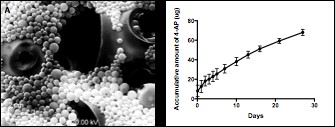Back to 2015 Annual Meeting Program
A Model for Time Dependent Delivery of 4-Aminopyridine (4-AP) to Peripheral Nerve: Construction and Testing of Sustained and Slow Release Microparticles
John C. Elfar, MD
Department of Orthopaedics, University of Rochester, Rochester, NY
We have recently shown that 4-AP can cause immediate transient return of function in animals which suffer sciatic nerve crush. The putative role for 4-AP in treating complete crush injuries is critically dependent on the ability to deliver this agent over the time course of recovery. We hypothesized that the slow release of active 4-AP could be accomplished using a standard system of slow release particles made from poly (lactic-co-glycolic acid) (PLGA).
Microparticles were constructed using water/oil/water double emulsion - a well-documented method for encapsulation of bio-active molecules (Makadia HK, 2011). 4-AP was dissolved in the primary water phase and then added into a larger volume of organic phase consisting of PLGA (50:50) in dichloromethane. Primary emulsion was accomplished with vigorous agitation and the primary emulsion was added into water containing 2% polyvinyl alcohol to perform second emulsion. The organic solvent was then allowed to evaporate to solidify the PLGA shell and seal 4-AP within the particles.
Scanning electron micrographs (SEM) of the resulting (4-AP)-PLGA particles is shown in Fig. A. Particles appeared to be of relatively uniform size (200 nm to 500 nm in diameter) and solid when analyzed with SEM. The release characteristics of (4-AP)-PLGA particles was analyzed using UV spectrophotometry to reveal a release profile which was on the order of weeks, Fig. B.
In this case, the loading capacity of PLGA particles was 0.8-1 ?g of 4-AP per mg of PLGA. We here demonstrate that a fast and short acting bioactive molecule can be formulated as part of a PLGA delivery system in particles which can potentially deliver a substantial, non-toxic level of active 4-AP to tissues. (4-AP)-loaded PLGA particles release 4-AP in appropriate concentrations as measured using UV spectrophotometer over a time course appropriate for the treatment of peripheral nerve injury.

Back to 2015 Annual Meeting Program
